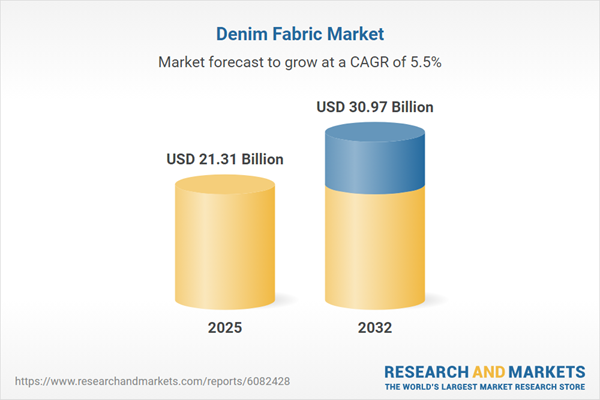Speak directly to the analyst to clarify any post sales queries you may have.
The denim fabric market is experiencing steady evolution as companies adapt to changing technologies, sustainability standards, and shifting consumer demand. Industry leaders are leveraging advances in production and supply chain transparency to address new challenges and unlock growth potential.
Market Snapshot: Denim Fabric Market Size and Growth
The Denim Fabric Market grew from USD 20.25 billion in 2024 to USD 21.31 billion in 2025. It is expected to continue growing at a CAGR of 5.45%, reaching USD 30.97 billion by 2032.
Scope & Segmentation
This report offers comprehensive analysis across the following segments, highlighting diverse technologies, applications, and end-user categories influencing the denim fabric market landscape:
- Denim Fabric Type: Acid wash, colored, organic, raw, sanforized, selvedge, stretched
- Raw Material: Cotton, polyester, spandex
- Functional Properties: Flame retardant, moisture-wicking, water resistant
- Texture: Non-textured denim, textured denim
- Dyeing Technique: Indigo dyeing, natural dyeing, sulfur dyeing
- Finishing Technique: Acid washing, bleaching, enzyme washing, laser finishing, ozone fading, sandblasting, stone washing
- Application: Accessories (bags, footwear, hats), apparel (jackets, jeans, shirts, skirts), home textiles (curtains, cushions, rugs)
- End-User: Children (boys, girls, toddlers), men, women
- Distribution Channel: Offline retail (departmental stores, specialty stores), online retail
- Region: Americas (North America, Latin America), Europe, Middle East & Africa (Europe, Middle East, Africa), Asia-Pacific (China, India, Japan, Australia, South Korea, Indonesia, Thailand, Malaysia, Singapore, Taiwan)
- Key Companies: Aarvee Denims & Exports Limited, Advance Denim Co., Ltd., Agua Fabrics Ltd., Arvind Limited, BERTO EG INDUSTRIA TESSILE SRL, Bossa Denim, CALIK DENIM, Canatiba Textil, Candiani S.p.A., Cone Denim LLC by Elevate Textiles, Inc., Jindal Worldwide Limited, Jinsuo Holdings Group Co., Ltd., KAIHARA CORPORATION, KG DENIM LIMITED, Kurabo Industries Ltd., Kuroki Co.,Ltd., Matesa Tekstil, Modern Denim Ltd., Orta Anadolu, PT Apac Inti Corpora, Raymond Limited, SANKO Holding A.Ş., Vicunha Textil SA, Westex by Milliken & Company
Key Takeaways
- Product innovation is fuelled by the interplay of fiber blends, distinctive finishes, and new dyeing techniques, which are expanding both performance and aesthetics.
- Sustainable manufacturing and circularity initiatives are increasingly integrated at scale, enabling responsible resource management across sourcing, production, and product lifecycle.
- Consumer demand is trending toward authenticity and supply chain transparency, pushing manufacturers to enhance traceability and ethical sourcing initiatives.
- Digital transformation, including automation, prototyping, and direct-to-consumer platforms, is enabling rapid response to market trends and deeper consumer engagement.
- Regional market dynamics vary: established retail channels and regulatory frameworks drive preferences in the Americas and Europe, while automation and scale are central in Asia-Pacific hubs.
- Strategic partnerships and vertical integration sharpen competitive positioning, allowing for operational agility and innovation amidst evolving market conditions.
Tariff Impact and Regional Shifts
Recently implemented tariff policies in the United States have prompted a reassessment of sourcing and supply chain strategies, intensifying the focus on near-shoring, regional diversification, and contract renegotiation. As companies adapt, investments in digital monitoring and alternate routes are mitigating risk and ensuring operational continuity in changing regulatory climates.
Methodology & Data Sources
This report utilizes a multi-tier research approach that combines secondary data analysis with primary interviews, stakeholder surveys, and expert panel workshops. Quantitative findings are cross-verified with industry sources, and advanced visualization techniques are applied to illustrate trends and relationships across segments.
Why This Report Matters
- Enables informed strategic planning by illuminating critical trends, risks, and opportunities in the denim fabric sector.
- Equips business leaders to benchmark against competitors, analyze regional strengths, and refine product portfolios for targeted end-users.
- Supports investment and operational decisions by synthesizing the latest insights on sustainability, technology adoption, and supply chain resilience.
Conclusion
This analysis provides a clear view of the forces reshaping the denim fabric industry and practical insights to guide decision-makers as the market evolves. Organizations that act on these trends can build agility and sustained competitive advantage.
Table of Contents
3. Executive Summary
4. Market Overview
7. Cumulative Impact of Artificial Intelligence 2025
Companies Mentioned
The companies profiled in this Denim Fabric market report include:- Aarvee Denims & Exports Limited
- Advance Denim Co., Ltd.
- Agua Fabrics Ltd.
- Arvind Limited
- BERTO EG INDUSTRIA TESSILE SRL
- Bossa Denim
- CALIK DENIM
- Canatiba Textil
- Candiani S.p.A.
- Cone Denim LLC by Elevate Textiles, Inc.
- Jindal Worldwide Limited
- Jinsuo Holdings Group Co., Ltd.
- KAIHARA CORPORATION
- KG DENIM LIMITED
- Kurabo Industries Ltd.
- Kuroki Co.,Ltd.
- Matesa Tekstil
- Modern Denim Ltd.
- Orta Anadolu
- PT Apac Inti Corpora
- Raymond Limited
- SANKO Holding A.Ş.
- Vicunha Textil SA
- Westex by Milliken & Company
Table Information
| Report Attribute | Details |
|---|---|
| No. of Pages | 194 |
| Published | November 2025 |
| Forecast Period | 2025 - 2032 |
| Estimated Market Value ( USD | $ 21.31 Billion |
| Forecasted Market Value ( USD | $ 30.97 Billion |
| Compound Annual Growth Rate | 5.4% |
| Regions Covered | Global |
| No. of Companies Mentioned | 25 |









